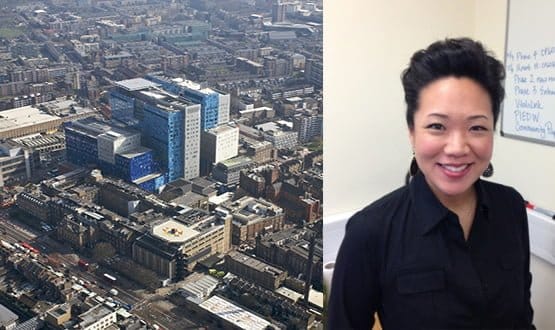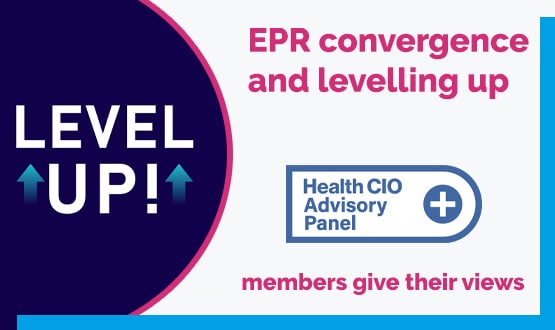Health CIO interview: Sarah Jensen
- 12 October 2016

Depending on how you look at it, running the IT for one of the country’s biggest and most complex trusts is a second or a third career for Sarah Jensen, the chief information officer of Barts Health.
Her first career was in finance: for nine years from the mid-1990s to the mid-2000s, she worked for Toyota Financial Services as an underwriter. Her second career was in healthcare IT: over the next eight years, she held a series of increasingly senior positions with Cerner Corporation.
Then, she decided she needed another challenge: “a third career, or something different in healthcare IT.” In the event, she took a job at Barts Health; which is working through a huge project to get all of its sites onto a single instance of Cerner Millennium.
From another perspective, though, her present job can be seen as the achievement of an early ambition. “I came from quite a deprived background, and when I was growing up we were quite dependent on social services,” says Jensen, who is Korean, although people tend to assume she is American.
“I always knew I would do something in public service. I did not know what; but as it turns out, it was something in the NHS.” At the same time, she adds, the NHS really needs people with a business background.
“You have to care,” she says, “because, let’s face it, the NHS is not glamorous. You will not be the next Bill Gates working here. So you have to care. But it does need to change, and it needs business skills to do that. Anyway. I arrived. For a year. And now I have been here for two years.”
Rolling out Millennium
Jensen was initially deputy director of informatics at Barts Health. She took up the CIO post a year ago, after her predecessor, Luke Readman, became CIO for Waltham Forest, Newham and Tower Hamlets clinical commissioning groups.
The big IT project since she arrived has been getting the trust onto that single instance of Cerner Millennium. When Barts Health was formed in a three-way merger in April 2012, one of its originating trusts, Barts and the London, had deployed Millennium as part of the London Programme for IT.
A second trust, Newham University Hospital, had also implemented Millennium, but outside programme. And the third, Whipps Cross University Hospital, was still largely paper-based. Before the national programme closed, therefore, the trust had to deploy Millennium at Whipps Cross and move the Barts and the London instance out of the BT data centre.
With the move “completed on time and on budget”, it got a code upgrade, and then launched the project to move Newham onto the same instance of the EPR; which, Jensen notes, “will be a big cost saving.” While all this has been going on, the trust’s chief clinical information officer, Charles Gutteridge, “has been working tirelessly to get Millennium used more widely.”
More big IT projects
At the same time, trust has been running further IT consolidation projects. It has been putting all of its hospitals onto one picture archiving and communications system and radiology information system from Sectra; a move that will require Newham General to stop using Millennium as a RIS, and adopt the Sectra RIS.
It has also been rationalising its pathology system since, almost inevitably, is three major hospital sites all use WinPath but have different instances of it. Getting them onto one, Jensen says, “is a huge amount of work” – and one that also affects the GP and home testing services that the trust runs for its local healthcare community.
As if that wasn’t enough, the trust has also been implementing Cerner’s health information exchange to share patient information in real-time with local GP practices, via Healthcare Gateway’s Medical Interoperability Gateway, and to share records with other local hospitals and clinics.
Meetings, meetings…
With all this going on, Jensen might have been expected to pick something like “project management” as the kind of business skill that the NHS could do with more of. But when she is asked what has struck her about the NHS, coming from a business background, she says she’s been impressed with the calibre of its staff.
What has taken her aback is “small things” like “meetings.” Sometimes, she says: “I look around a meeting, and think about how much it must have cost to get all these people around a table, and wonder if we really needed to do that, and whether we couldn’t have done some of the work by phone, or Skype,” she says.
Also, she has been surprised by the general lack of awareness of how the NHS operates. “People don’t seem to know where the money comes from,” she says. “They don’t seem to know where we get our business from, who our commissioners are, when we are competing against [other local trusts].
“That matters, because sometimes people get asked to change the way they do things, and they don’t know why. They don’t know it’s because of a new CQUIN payment, or a CQC requirement, or whatever it is. They don’t understand how the money flows; how that impacts a trust like ours; how that affects what we do every day.”
A strategic role (with squeaking hedgehogs)
NHS chief information officers, Jensen adds, can no longer afford to ignore such issues, if they ever could. “The days of having an IT director looking after the ‘tin and wires’ have gone,” she says. “This is becoming a much more strategic role; it is about how IT underpins services or delivers cost savings.
“And vice-versa. It is about getting other people to think of us not just as ‘the people who come in and fix the PC’, but as the people who need to be brought in at an early stage to explain how IT can support change.
“Because I still get business cases that are two or three years old that say ‘we are going to triple activity’ but do not say ‘we will need triple our current number of PCs’ or ‘we will need more Millennium licenses’.”
This, she acknowledges in a lighter hearted moment towards the end of the interview, is not always easy at a trust like Barts, where just informing staff about big IT projects can be a challenge. “We send out emails and newsletters and people just don’t read them!” she says.
“The Royal London is a PFI hospital, so we can’t put up posters without paying a lot to do it; and it has all these small staff rooms where people can go and hide.” The much older Whipps Cross at least has a large canteen that is a meeting place at lunchtime.
“When we were doing the PACS/RIS change we stood outside and grabbed people to tell them about it,” she says, laughing at the memory with the trust’s communications lead, Ellie Banner-Ball.
“We even had these squeaking hedgehogs [from Igel, the supplier of the imaging workstations] and Ellie and I stood there squeaking these hedgehogs at people to get them to talk to us.”
Valuing the NHS
Jensen says “visibility is an issue” in her role. She gets asked for a lot of customer meetings, to attend a lot of events and conferences, and to give a lot of interviews; but she turns down almost all requests because she feels the trust needs her time – and, of course, it is expensive.
However, she has made an exception for local schools. “In East London, there is a programme to help school kids to start thinking about careers, and that is something the NHS really needs to be part of,” she says.
“How do we get somebody to think about a career in technology? How do we get them to think about a career in the health service? The NHS doesn’t just need doctors and nurses, it also needs operations people, and finance people, and technology people.”
It also needs people just to “realise it is wonderful”, she adds. “This hospital was founded in 1123, and most of the people around here, even the people who work here, don’t even realise that. To me, it seems amazing. There are countries that are not as old as that.
“We should be proud of the NHS. We should nurture it. There are lots of things we need to change about it. But we should never forget that.”




